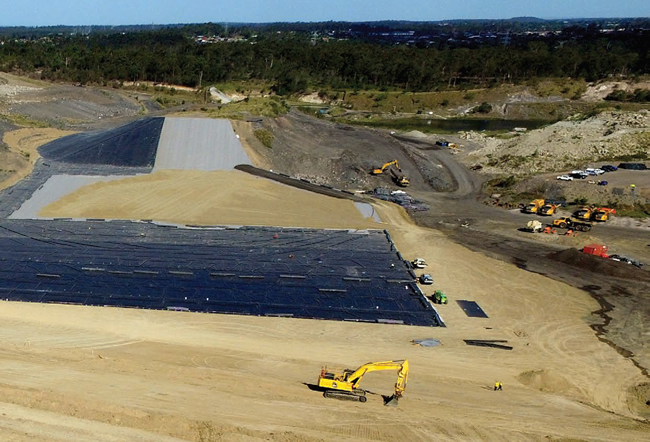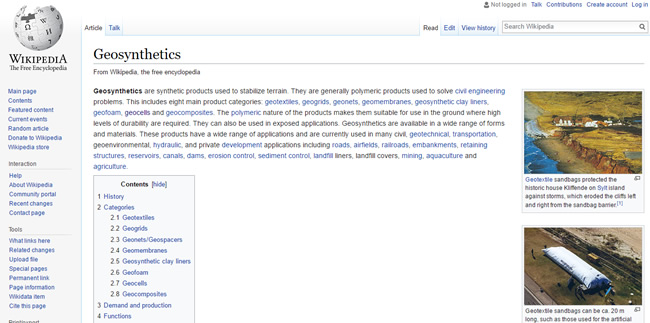By Preston Kendall – The International Geosynthetics Society has set a goal of getting geosynthetics engineering information into undergraduate civil engineering programs. This is being accomplished in part through the international Educate the Educators program and the newly created Educate the Students program. The larger task of outreach is certainly ambitious. The fields of civil and geotechnical engineering are “as old as dirt,” but geosynthetics have only been around since the 1950s, and the field’s formal terms did not begin to crystallize until 1977 when Dr. JP Giroud coined “geotextile” and “geomembrane” in a lecture at what is now recognized as the 1st International Conference on Geosynthetics.

These polymeric materials have enjoyed a monumental rise in adoption into applications over the last 40 years, but I was in university not long ago and I don’t recall the word geosynthetics having ever been presented in my curriculum. In fact, I grew up and received two college degrees in a US state that I later learned to be an international geosynthetics hub: Georgia.
FINDING WORK
When I was in my last semester of civil engineering graduate school, I came across a job description that appeared to be written with me in mind. It offered opportunity to learn from experienced civil engineers, to get field work on large civil sites, to work in a lab, to do research and publish papers, to learn the commercial side of civil engineering, and to interact with civil designers regularly. As I was soon to graduate, I thought, wow, this is my dream job!
There was one other key detail in this job description: I would be working in the field of “Geosynthetics”. Huh?

I had a vague notion of what geosynthetics were. I had seen the identically dressed people at career fairs with branded collared shirts. They would enthusiastically show you samples of black plastic grids and synthetic fabrics. They didn’t represent any household names like some of the other companies at the career fair, but through them I became aware that there was an industry behind the use of synthetics in civil and environmental engineering. I had also done a somewhat related senior project involving inflatable rubber dams, but I still don’t recall the word geosynthetics ever coming up during that project or the 8 years of university education.
Apparently, it was an area where my academic life was just touching the surface of what students call “the real world.”
Most students are aware that there is a difference between student life and the real world. They realize that there is much to learn in those first crucial years in the work force. But what if you came across a job that was based on materials that were never even mentioned in your university program? This is where I found myself in 2012.
I looked to my professors to get some reassurance. One response that stands out in my memory was from a geotechnical professor who said that geosynthetics are analogous to steel reinforcement in concrete. This was about where my geosynthetics education in university began and ended.
ENTERING THE FIELD … ONLINE
A month after graduation, my professional education began. I read up on geosynthetics as best I could in the few weeks between graduation and day one in the workforce. They say “you don’t know what you’ve got till it’s gone”. This was very true of the literature access that university enrolment allows. After graduation, Poof! It was gone. My unlimited access to journal publications was gone.
The internet became my best source for geosynthetics information.

Wikipedia was one of my main sources. It’s a website that has grown dramatically in line with my own education from middle school through completing my civil engineering graduate program.
When you search something and Wikipedia is one of the top results, it is usually a good indication that you have found something real.
When I googled “geosynthetics” back in 2012, Wikipedia’s entry was one of the top results. What I found was not much different from what you find in that same entry today. It is useful but in no way comprehensive. It introduced the diversity of geosynthetic products, but provided very little information on the science and engineering behind the materials.

Locating abstracts in online journals, including abstracts for papers authored by some of my future colleagues, provided a bit more, but without an expensive subscription to these publications I did not have access.
I did not know back then that International Geosynthetics Society members have free access to the IGS Journals: Geosynthetics International and Geotextiles & Geomembranes. Both journals are rated in the Top 10 of the 230+ geotechnical journals rated by SCImago.
There may have been a time in my life when I would have been ashamed to write publicly about how I used (and still use!) Wikipedia. After all, the entries can be written by anybody and they are not always properly vetted. But, the website has an important place—particularly for introduction to information we might pursue on a deeper level. It is part of this new era of digital exchange. We expect information to be at our fingertips and we want it fast. The internet has allowed for this change and Wikipedia has done a good job of delivering.
Today, being wiser about digital resources, I know that civil engineers and students of civil engineering have a number of freely available resources to consult beyond Wikipedia. These include sites such as:
- International Geosynthetics Society – IGS has numerous general and technical documents freely available on its website. Plus: members get free electronic access to the IGS Journals and free access to an online database of more than 1800 proceedings papers. Student memberships are free! Also, many IGS chapters have free or nominal fees for student members.
- IGS Chapter websites – There are more than 40 international chapters of the International Geosynthetics Society, and many of them openly share documents, presentations, and even some papers, such as from their national conferences. These resources are routinely published in the primary language of the country or region in which these chapters are based.
- Geosynthetic Institute – GSI has more than 30 technical white papers for free access on its website. Its generic specifications are also of tremendous value for learning about how geosynthetics are determined to be of high quality and suitable for an application.
- Geosynthetica – The Geosynthetica family of publications began in 1999. (Wikipedia was founded in 2001.) The online publications are open to all and do not require any registration.
- Geosynthetics companies – Not to be overlooked! Geosynthetics manufacturers, installers, and consultants regularly publish papers or versions of their conference papers on their own websites. They also produce unique technical documents and project references that provide details of how to properly utilize geosynthetics. (My own employer, Geofabrics Australasia, has produced educational videos, published case histories, authored material selection articles, and more.)
BACK TO MY GEOSYNTHETICS EDUCATION & CAREER
Less than two months after graduating with a Master’s in Civil Engineering, I was working for a geosythetics manufacturer on the other side of the world. I had grown up in the geosynthetics-producing state of Georgia in the United States, but it wasn’t until I entered the engineering work force with an adventurous 10,000-mile move to Australia that I really began to understand the value of all the geosyntetic publications out there. It was also where I began to understand one of the great benefits of being a member of the International Geosynthetics Society.
Before I had attended any meetings, participated in any committees, or read any newsletters, I was using my membership extensively through its fantastic publication access. I had lost all of the web access to journals that my university provided but now I could access the key journals relevant to my industry.

My university education did a great job on the “geo” portion of “geosynthetics,” and I have been able to put my foundation in science and engineering to good use. The “synthetics” portion, however, is something I’ve had to discover and explore since I entered the workforce.
It has been a very engaging and rewarding experience so far.
Among new civil engineering graduates, my experience was unique. Many of my classmates entered different sectors of the civil and environmental engineering field. I’m sure that they come across geosynthetics in their roles, but I am fairly certain that they do not have a good grasp of all the science and potential that is behind geosynthetics and their applications. More than likely, many of them still see geosynthetics as I did when I first came across it at the career fair.
I now know that geosythetics are commonplace in “the real world”. They support the ground I walk on and the roads I drive on. They protect the water I drink and the land I use. These are fundamental tasks of civil infrastructure.
Geosynthetics as a civil engineering discipline is real, it is here, and it is growing rapidly. It is critical that we prepare the next generation of engineers to meet an industry that has become fundamental to modern geotechnical practice. Civil engineers have a moral duty to society and society demands proper application of geosynthetics. Promoting the appropriate application of geosynthetics is the core principle of the International Geosynthetics Society and to support this principle, the organization is endeavouring to make geosynthetics part of the undergraduate curriculum of the civil engineering field.
I believe there is something else we can all do to promote the appropriate use of geosynthetics.
In assisting this effort, here are my recommendations:
- Embrace the internet and open sharing of information
- Wikipedia has huge potential. Join the community on Wikipedia and contribute content or help vet content and add citations to strengthen the material. For other venues, such as Geosynthetica, contribute an article (as I have this one). Co-author a paper for a conference, particularly those under the IGS Auspices so that the information has a greater chance of being added to the IGS’s extensive online library for its members.
- Join the International Geosynthetics Society. Consider joining a committee. Attend an event. Contribute something to the IGS News.
Start small but remain involved. This is a strong, ever-growing field. It influences every sector of civil engineering. Whether you are in the field or in school, your voice is important. Take advantage of the easily available resources on the internet, interact with their publishers, and become a contributor.
Preston Kendall worked for Geofabrics Australasia Pty Ltd when this article was originally published.











